Ten Minute Master: DSP Monitoring
Many studios struggle with acoustic issues and monitoring, but DSP systems aim to negate them. Russ Hepworth-Sawyer explains. KRK’s ERGO room correction system is a standalone processor with a handy monitor volume control. We have all struggled at one time or another with the troubling issues of room acoustics, monitor placement and the subsequent treatment. Modern […]
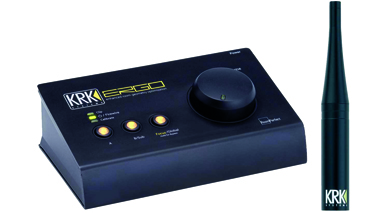
Many studios struggle with acoustic issues and monitoring, but DSP systems aim to negate them. Russ Hepworth-Sawyer explains.
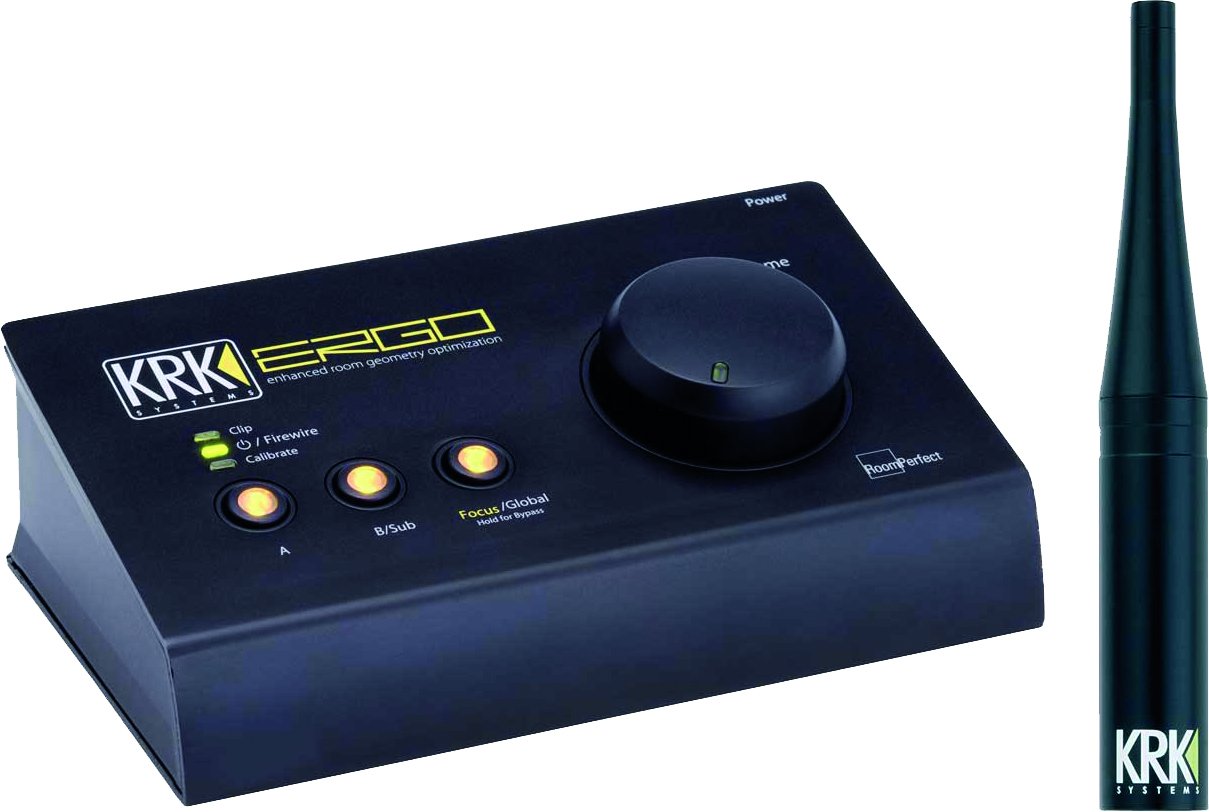
KRK’s ERGO room correction system is a standalone processor with a handy monitor volume control.
We have all struggled at one time or another with the troubling issues of room acoustics, monitor placement and the subsequent treatment. Modern DSP monitoring appears to be gaining quite a lot of traction in both small and large environments, especially within the post- production market where listeners require an even experience whatever the circumstances. But what sonically can DSP monitors really overcome, and what can we get out of this new technology?
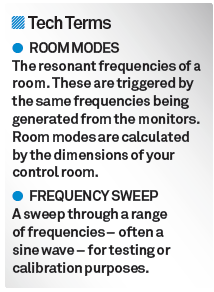
All listening environments possess characteristics that will affect how you hear a mix. These can range from accentuated bass, shifted stereo image and a loss of high-frequency sparkle to elongated reverberation times. Professionally designed spaces are specifically centred around the listening position to ensure that the acoustic treatment can be designed and applied to yield very specific results. However, rooms that are not professionally designed and constructed can still be physically tamed and adapted to take on less intrusive characteristics. Let’s take a look at the common issues and traditional solutions.
Sound reflects off surfaces in a room and bounces back towards you, causing acoustic interference. These reflections can collide and present themselves as either enhancements (peaks) or holes (nulls) in the frequency spectrum. Perhaps it might be perfect to have no reflections at all (as found in as an anechoic chamber) but this is neither practical nor desirable. Across the whole frequency spectrum, these reflections, if untamed, can be quite damaging to the direct impression of your music. Similarly, the mode of a room – its natural resonance – should be addressed as this will cause peaks at that frequency and its harmonics when triggered by the monitors.
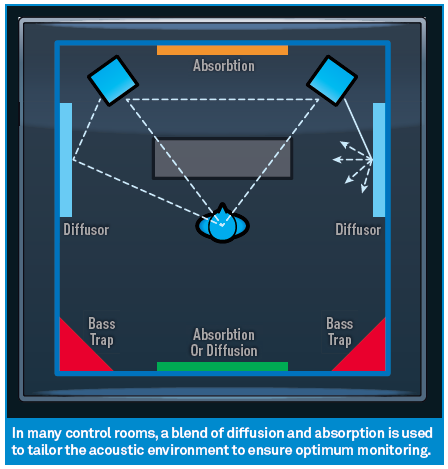
Traditional solutions
It can be beneficial to trial monitors at different positions in a space to find out where they react and interact best with the room. Of course, this is not always practical in smaller spaces such as home or project studios, where differing monitor placements can be quite difficult simply because of space restrictions. Setting up monitors in the traditional equilateral triangle between the monitors and the listener at the correct height will assist the direct sound. Our attention, then, should be turned to the issue of the room’s reflections.
By employing a number of tried-and-tested solutions these reflections and modes can be tamed or controlled. It is common to handle reflections by either absorption or diffusion. Absorbing sonic energy is achieved using employing either foam solutions such as those from EQacoustics.com or Auralex.com or to construct some permanent and efficient rockwool absorbers. Plain sheets of rockwool or foam are very good at mid to high frequencies, but for trapping bass, greater depths of material are required, capturing the longer wavelengths.

One of the best applications of diffusion is where the direct sound from the monitors is merged with reflections from the side walls. This blurs the focus and stereo image from the monitors. By diffusing or scattering the direction of those reflections the direct signal becomes the strongest to reach you, focusing up the intended stereo image.
Enter DSP
For many years now, hi-fi manufacturers have included rudimentary digital signal processing (DSP) into their all-in-one systems. Settings such as ‘Pop’, ‘Rock’, ‘Jazz’ and so on have adorned these machines, adding EQ, reverb and even some phase adjustment to increase the stereo width. Professionally, it has been a long-standing practice for live sound engineers to utilise 32-band, third-octave graphic equalizers to tailor their equipment to the venue. Over time, technique has become more advanced, covering a number of processes including EQ. The practice of ‘tailoring’ loudspeakers to the room has now transferred to the recording studio, with many respected companies adopting the technology.
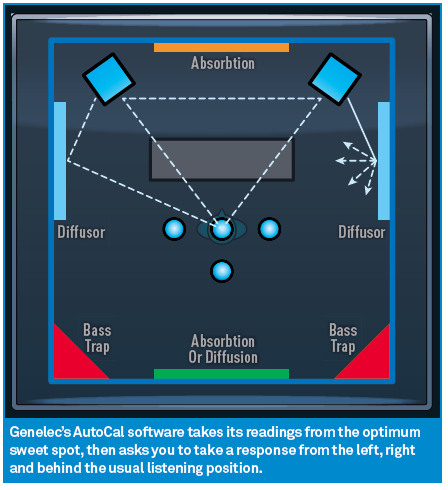
Optimum response
DSP systems such as those provided by Genelec or KRK utilise a combination of hardware, software and calibration mic to measure the environment. The mic, placed on a stand at the appropriate height and position for the software, analyses the sonic characteristics of the room. Genelec’s AutoCal, for example, sends a frequency sweep from the left and right speakers at a pre-determined amplitude. For standard stereo calibration these are tested at the optimum listening position, to the left, right and behind the ‘sweet spot’. This provides the software with the necessary image to make subtle corrections and optimise the listening experience.
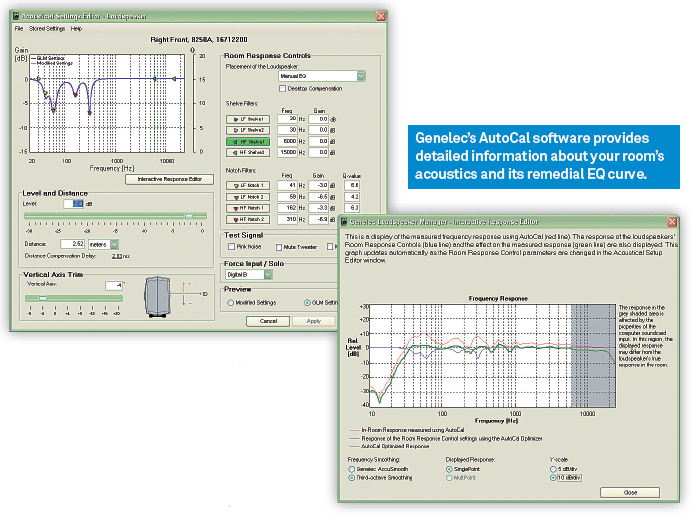
Depending on the system, the DSP will make the necessary adjustments for your monitors and present its ‘best fit’. In the case of Genelec’s AutoCal, a curve is displayed demonstrating the response of the room. Another ‘compensating’ EQ curve is also displayed alongside showing you the curve AutoCal has applied to the signal. Between the two is the response you will hear in the room. To achieve this, Genelec employs four editable parametric DSP notch filters and four parametric DSP shelving filters for each loudspeaker.
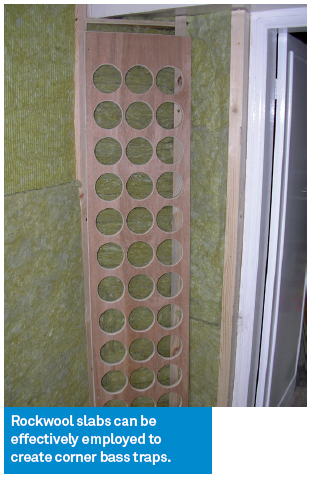
Another interesting feature of Genelec’s AutoCal is MultiPoint, providing the ability to use the calibration tool to create three differing monitoring positions: one for the engineer, one for the producer and perhaps one for the client, sitting on the studio sofa. This is achieved by phase alterations between the left and right monitors so that the two are aligned when they reach the listening position.
Some DSP monitoring solutions can correct timing differences between the left and right monitors. This should enable your monitors to work in harmony with the reflections and subtle issues of your room. For 5.1 surround sound monitoring systems, this can be extremely effective, especially where rear speakers cannot be placed in the optimum position without posing a health and safety risk, perhaps by obstructing access to a fire escape, for example.

DSP monitoring comes in many differing forms, from the DSP being housed within the loudspeakers themselves – in the case of Genelec or Dynaudio’s AIR series – to standalone units such as KRK’s ERGO room correction system. ERGO, being a standalone unit, can therefore work with any monitors you already possess.
It is clear, therefore, that DSP monitoring can go a long way to correcting underlying acoustic issues within a room. There are certain things DSP cannot repair completely within a room easily, such as a lack of diffusion from side walls, for example. Overcoming this with diffusors placed at the appropriate places married with a DSP monitoring system might present a dramatic improvement over non-DSP monitors in the same room with the same level of treatment.